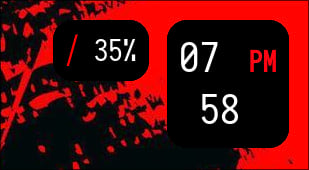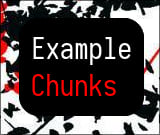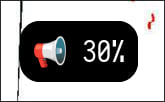36 releases (6 breaking)
| 0.7.5 | Jan 24, 2025 |
|---|---|
| 0.7.1 | Dec 30, 2024 |
| 0.6.3 | Nov 27, 2024 |
#521 in GUI
3MB
868 lines
Chunks-rs
Description
A library that simplifies the process of making widgets for Wayland Compositors.



Chunks uses GTK4 and GTK4 Layer Shell at its core, and comes stock with a listener for the Hyprland IPC. This helps with changing Widget states when something changes, such as making the current window fullscreen.
Usage
Make sure you have GTK4 and GTK4-Layer-Shell installed on your system.
For more in depth examples, please refer to example-chunks
[dependencies]
chunks-rs = "0.7.5"
This will create a storage widget, similar to the one in the screenshot:
const STYLE: &str = "
window {
background-color: transparent;
}
#storage {
font-size: 34px;
background-color: #000000;
color: #FFFFFF;
}
";
fn main() {
let factory = Factory::new("chunk.factory");
let chunks = |factory: GtkApp| {
storage(&factory);
load_css(STYLE);
};
factory.pollute(chunks);
}
fn storage(factory: &GtkApp) {
let tag = tag_label("storage");
let margins = vec![(Edge::Top, 20), (Edge::Right, 160)];
let anchors = EdgeConfig::TOP_RIGHT.to_vec();
let storage_closure = || {
let text = format!(
"<span foreground='#FFFFFF'>{:.0}%</span>",
Internal::get_storage(),
);
text
};
Internal::update_storage(&tag, storage_closure);
Chunk::new(
factory.clone(),
"Storage",
tag,
margins,
anchors,
Layer::Bottom,
false, // change to true for tag_revealer
)
.build();
}
All widgets have a CSS class of "window". It is important to make the GTK4 windows transparent, as the Layer Shell handles the widget's appearance.
Slabs & Plates
Chunks has two types of Popup widgets:
- Slabs: Display dynamically, triggered by changes in underlying text (e.g., volume detection).
- Plates: Display once at startup, then disappear after a set duration (e.g., welcome messages).
Both share similar implementations but differ in their display behavior.
These widget types do not need a designated layer, as they are set to Overlay by default. Instead of a layer, insert the number (in seconds) that you would like the Slab/Plate to show for.
Slab::new(
factory.clone(),
"Volume",
tag,
margins,
anchors,
2,
)
.build();
Plate::new(
factory.clone(),
"Greeter",
tag,
margins,
anchors,
2,
)
.build();
Bars
Chunks recently added a new widget type - Bars - which are used to display a taskbar, similar to Waybar or Polybar. These taskbars are broken down into a collection of widgets, such as a clock, a workspace switcher, and a system tray.
Bar implementation is similar to the other widgets, but with a few key differences:
- Takes a vector of Tags, which are used to determine a collection of widgets to be displayed on the taskbar.
- Takes an Orientation type (Horizontal or Vertical) to determine the layout of the taskbar.
fn bar(factory: &GtkApp) {
let mut workspaces = vec![];
for i in 0..5 {
let workspace = tag_button("workspace");
let num = i + 1;
Internal::static_button(&workspace, move || {
switch_workspace(num).expect("Failed to switch workspace")
});
Internal::static_widget(&workspace, (num).to_string());
workspaces.push(workspace);
}
let margins = vec![(Edge::Top, 6), (Edge::Bottom, 6), (Edge::Left, 6)];
let anchors = vec![(Edge::Top, true), (Edge::Left, true), (Edge::Bottom, true)];
Bar::new(
factory.clone(),
"Storage",
workspaces,
margins,
anchors,
Vertical,
)
.build();
}
fn switch_workspace(number: i32) -> Result<(), std::io::Error> {
Command::new("hyprctl")
.args(&["dispatch", "workspace", &number.to_string()])
.output()?;
Ok(())
}
Similar to the application window, the taskbar has a default CSS class of "taskbar".
The switch_workspace function is used to switch workspaces using hyprctl. This is then passed through to your Tag using static_button, which gives your button functionality.
When implementing Tags of the button type, you can use virtually any function in place of switch_workspace.
Argmuent Parsing
Passing arguments through to your application is a bit more complicated than usual. To adhere to GTK4's command line argument handling, you must use the following code:
fn main() {
let factory = Factory::new("chunk.factory");
let chunks = |app: &GtkApp, cmd_line: &GtkCmdLine| {
let args = cmd_line.arguments();
if args.len() < 2 {
eprintln!("No command provided");
return 1;
}
match args[1].to_str().unwrap_or_default() {
"storage" => {
storage(app);
load_css(STYLE);
0
}
arg => {
eprintln!("Unknown argument: {arg}");
1
}
}
};
// It may seem redundant to collect the args a second time, but to avoid type errors, it is necessary.
let args: Vec<String> = env::args().collect();
factory.pollute_with_args(chunks, args);
}
Special Thanks to:
- Bhaumik, for helping me see beyond my own desires for this project.
Dependencies
~30–42MB
~801K SLoC